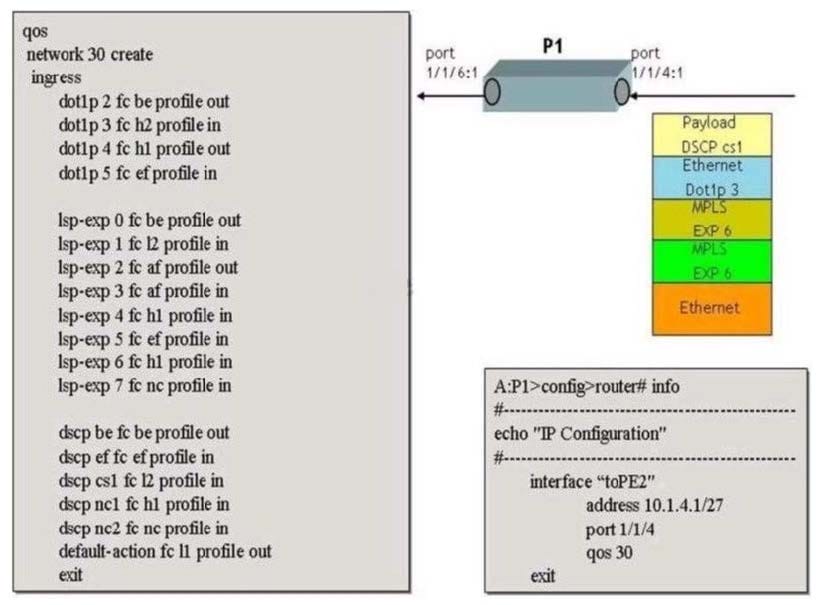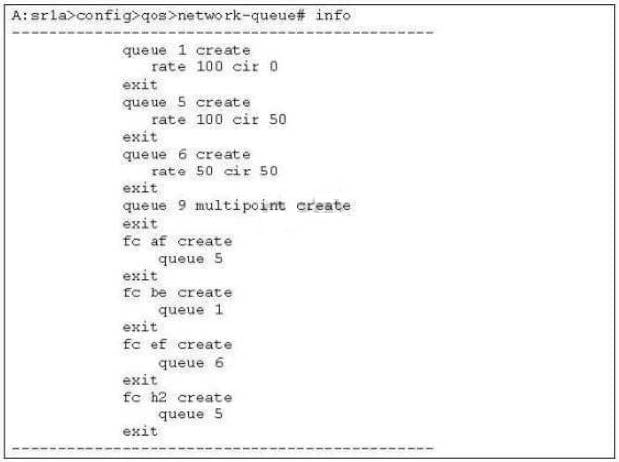Exam Details
Exam Code
:4A0-107Exam Name
:Nokia Quality of ServiceCertification
:Nokia CertificationsVendor
:NokiaTotal Questions
:212 Q&AsLast Updated
:Apr 13, 2025
Nokia Nokia Certifications 4A0-107 Questions & Answers
-
Question 111:
Which of the following statements about the consequences of congestion is TRUE?
A. Negative jitter results in a smaller than expected interval between transmitted packets.
B. Jitter does not have any effect on the quality of video applications.
C. Serialization delay is not affected by congestion.
D. Queuing delay is a fixed form of delay in networks.
-
Question 112:
Which of the following statements about the DiffServ and IntServ QoS models is FALSE?
A. IntServ uses a protocol like RSVP to provide QoS guarantees on a per-flow basis.
B. DiffServ groups multiple microflows into bigger streams called macro flows.
C. Intserv requires that network routers allocate resources for thousands of individual flows.
D. Diffserv classifies packets into forwarding classes only at the first network hop.
-
Question 113:
How does an IOM3 improve the queue usage over an IOM2 in a Nokia 7750 SR? (Choose two)
A. The IOM3 adds more memory to both forwarding complexes which increases the total number of queues available.
B. The IOM3 only contains a single forwarding complex which reduces the number of queues used.
C. The IOM3 allows multiple forwarding classes to be assigned to a single queue.
D. The IOM3 allows queues to be dynamically allocated between ingress and egress.
E. The IOM3 has a larger CPU capable of tracking active hardware queue utilization and adjusting memory allocation accordingly.
-
Question 114:
Which of the following statements BEST describes the IntServ model?
A. Has the ability to distinguish traffic in 32 different ways.
B. Uses the RSVP protocol to create microflows through a network.
C. Has the ability to manually configure foiwarding classes through a network.
D. Uses the RSVP protocol to create macroflows through a network.
-
Question 115:
Click the exhibit button below.

Based on the configuration of the network policy (below), what will be the forwarding class associated with a MPLS encapsulated customer packet that arrives on a dotlQ encapsulated network port 1/1/4:1 on P1 with the following characteristics:
EXP value = 6 DSCP value = cs1 Dot1pvalue = 3 A.EF
B. H1
C. L1
D. H2
E. L2
-
Question 116:
Which of the following statements regarding the default scheduler in the Nokia 7750 SR are TRUE? (Choose two)
A. There are a maximum of 8 levels of priority serviced using a round-robin algorithm.
B. The default scheduler will spend an equal amount of time in each queue, as long as there is traffic present
C. The H1 internal forwarding class will receive its CIR before AF traffic.
D. Orphaned queues will be scheduled out of the BE queue.
E. A queue servicing EF and AF traffic will require explicit configuration to set the queue to expedited.
-
Question 117:
Which of the following statements regarding scheduling are TRUE? (Choose two)
A. Scheduler policies cannot be children of an egress port-scheduler.
B. HQoS provides a static method of allocating scheduling resources to each queue and/or child.
C. Scheduler policies can be applied to the MDA to schedule network ingress traffic.
D. Every time a scheduler-policy is assigned to a SAP, a new hardware scheduler is created to service the SAP.
E. A scheduler applied to multiple SAPs within the same service will result in a single hardware scheduler operating across all SAPs within the service.
-
Question 118:
On the Nokia 7750 SR, what is the maximum number of queues that a single SAP-ingress policy can support in a VPLS?
A. 16
B. 8
C. 32
D. 48
E. 56
-
Question 119:
Click the exhibit button below. A network operator has configured a network-queue policy to map forwarding classes to queues, as shown in the exhibit below. Based on the default scheduling behavior of the Nokia 7750 SR, in which order will packets be serviced?

A. All in-profile packets in round-robin, then all out-of-profile packets in biased round-robin.
B. In-profile EF packets, then in-profile H2 packets, then in-profile AF packets, then out-of-profile EF packets, then out-of-profile H2 and AF packets, and then out-of-profile BE packets.
C. In-profile EF, H2 and AF packets, then out-of-profile H2, AF and BE packets in biased round-robin.
D. In-profile EF packets, then in-profile H2 and AF packets, then out-of-profile H2, AF and BE packets in biased round-robin.
E. In-profile EF and H2 packets, then in-profile AF packets, then out-of-profile H2, AF and BE packets in biased round-robin.
-
Question 120:
Which of the following statements are TRUE regarding the PE device in a QoS enabled network? (Choose two)
A. A device that provides no differentiation between customer traffic flows.
B. A device that classifies and marks customer traffic.
C. A device that uses MPLS EXP bits to differentiate between traffic flows.
D. A device that creates macroflows towards the core from multiple customer sites.
E. A device that passes macroflows while optionally changing QoS markings.
Related Exams:
4A0-100
Nokia IP Networks and Services Fundamentals4A0-101
Nokia Interior Routing Protocols4A0-102
Nokia Border Gateway Protocol for Internet Routing4A0-103
Nokia Multiprotocol Label Switching4A0-104
Nokia Services Architecture4A0-105
Nokia Virtual Private LAN Services4A0-106
Nokia Virtual Private Routed Networks4A0-107
Nokia Quality of Service4A0-108
Nokia Multicast Protocols4A0-109
Alcatel-Lucent Triple Play Services
Tips on How to Prepare for the Exams
Nowadays, the certification exams become more and more important and required by more and more enterprises when applying for a job. But how to prepare for the exam effectively? How to prepare for the exam in a short time with less efforts? How to get a ideal result and how to find the most reliable resources? Here on Vcedump.com, you will find all the answers. Vcedump.com provide not only Nokia exam questions, answers and explanations but also complete assistance on your exam preparation and certification application. If you are confused on your 4A0-107 exam preparations and Nokia certification application, do not hesitate to visit our Vcedump.com to find your solutions here.